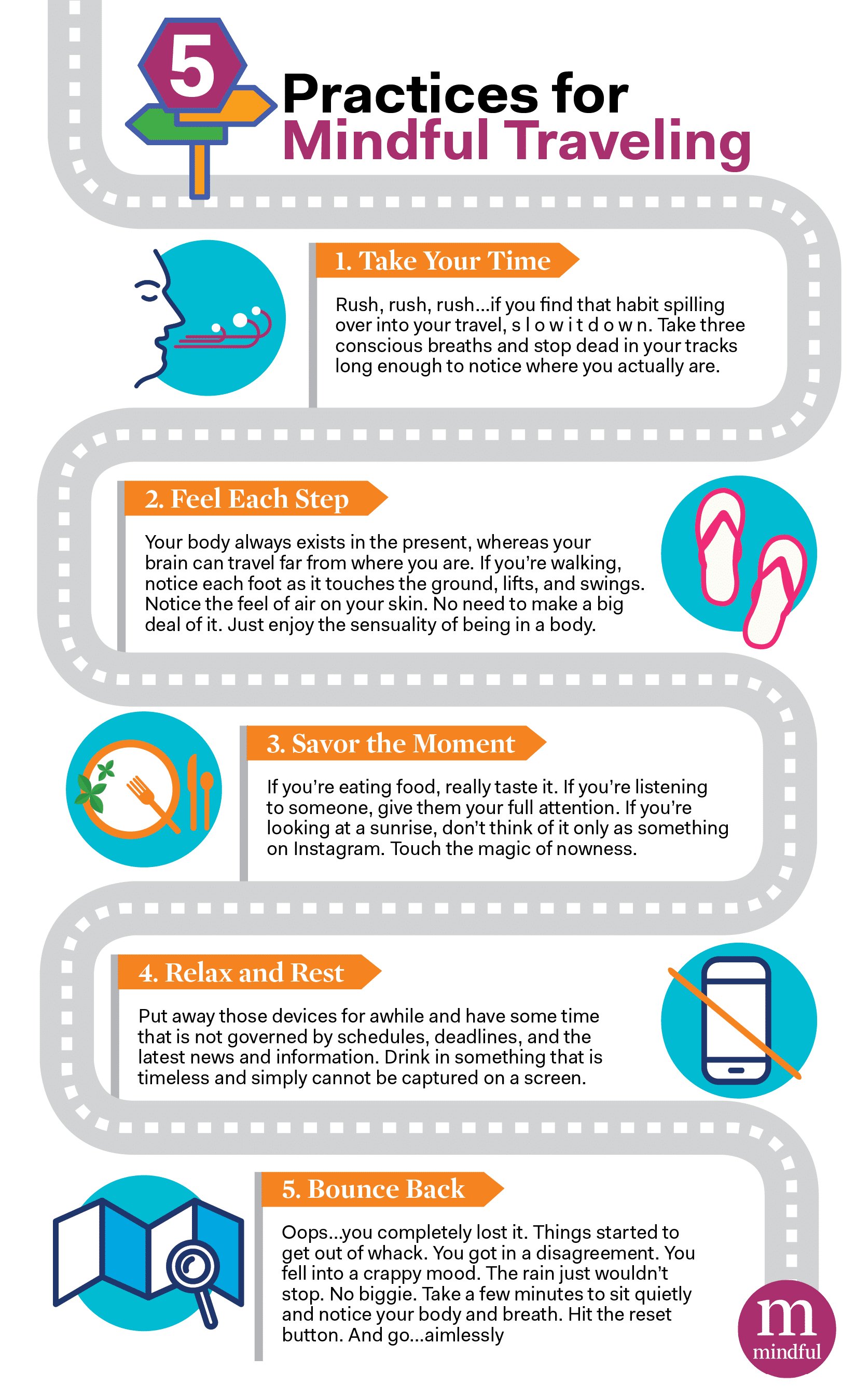
When you first hear these words joined together—mindful + travel—they’re most likely going to conjure up the notion of being hyper-conscious and conscientious about each and every little detail of everything you’re doing when you’re on vacation or out there one the road.
Now, where is the fun in that?
Yes, it’s a good idea to pay attention and to savor what’s happening in the moment, because any time you’re actually present for what you’re experiencing, life is that much richer. It is helpful, then, to have a few reminders about how to be in the moment while you’re travelling (see tips below), but one of the most mindful things you can do when you’re travelling is to let go—to give up any big sense of purpose, the kind of thing that probably drives you in your regular life. It’s time to break free and become…
…a flâneur,
…which is defined by the American Heritage Dictionary (a little harshly) as “an aimless idler,” or (more appreciatively) in the Paris Review as a “stroller, a passionate wanderer.” The poet Baudelaire praised the flâneur as someone who, by strolling about amid the kaleidoscope of daily life, finds “the timeless within the transitory.” Tied to no purpose, what passes before their eyes—and enters through their other senses—can be appreciated on the spot for simply being there.
Even when I’m just in my own neighbourhood, I love to do this kind of strolling, with no aim in mind, and it never fails to yield small (and sometimes big) surprises and delights. The other day I was wandering in my neighborhood and I came upon a small table blocking the sidewalk. Behind the table was an equally small chair, and behind the chair was a path leading up a small hill through some bushes into someone’s backyard with children’s things strewn about. On the little table were a few very ordinary rocks. The young proprietor of this little stand was not there at the time, but next to the table was a multi-colored sign in chalk: Free Rocks.
We generally think of mindfulness as counteracting our wandering mind, and it does, but it can be larger than that. It can include the practice of just noticing one thing after another as we let ourselves out to play.
That image has stuck with me now for a while. And it never fails to make me laugh, and smile in appreciation for the child who concocted the idea. When you wander, the spring you tighten inside in order to secure your purpose and direction can unwind.
If travel is to truly refresh you, it needs to contain a healthy dose of aimless wandering. Yes, we generally think of mindfulness as counteracting our wandering mind, and it does, but it can be larger than that. It can include the practice of just noticing one thing after another as we let ourselves out to play. We don’t have to take things too seriously. We are amused.
Mindful Travel Challenge: Take time to Have No Plan
We’ve all gone for a stroll or taken our dog for a walk. To turn a walk into aimless wandering involves mainly a slight shift in attitude. You commit to having the loosest possible plan. The highest and most enjoyable form of wandering is also as free as possible from time constraints.
At first, your mind may begin to seize on plans and looming problems to be solved. You may think if you don’t mentally address them, they won’t be taken care of, or if you think about them enough, you can make them go away. Instead, just as in a regular meditation session you would come back to your breath or the feeling of your backside on a chair or cushion, here you come back to whatever next catches your eye or ear or nose.
But what about planes, trains, and automobiles, you may ask? You can’t exactly be aimless when you’re making you way through an airport, navigating a freeway exit, or searching yet again for a place for your daughter to pee. Too true. You can’t be “aimless” for every part of your journey, but you can roll with the punches and bounce with the ups and downs. The key is to expect and accept the inevitable stress, and remind yourself that you are not, in fact, in a rush. You will get there when you get there.
One of the keys to wandering is to be driven by unending curiosity. Since you don’t have a plan, it’s the questions that emerge from your mind that drive you onward: “What’s that? Where does that lead? What’s that in the window?”
If you’re in a city, streets with little stores can be endlessly intriguing. Old junk shops and used book and record stores—stores of all kinds can draw you in—and it’s great to go inside and browse and meet the owners and workers, but it’s good to avoid turning it into a ravenous shopping spree. Maybe focus on one really good thing. Perhaps you can try what a friend of mine calls “appreciation shopping.” You’re not there to buy, but merely to appreciate.”
In the wild, aimless wandering is about what catches your eye—and ear and nose and skin and mouth—in nature. You just let yourself become part of the natural world, because…you are! If you find yourself stressing and rushing to the next thing or destination, ease up a bit. Aimless wandering is not an extreme sport. It’s about leisure, not pushing the envelope. (That’s what base jumping and wingsuit flying are for.)
Even if you’re travelling on a set path—like a hiking or walking trail—you can still aimlessly wander. It can take the form of venturing off the path a bit at points or simply stopping to admire or savor. It’s also good to let a little boredom set in. On the other side of boredom lies wonder and awe, but it can take a little while to sneak up on you.
You might be running or speed walking to get your daily dose of cardio, the world will go by in more of a blur, but you can still drink it in, and also at the same time pay a lot of attention to your interoception: your sense of your overall physiological condition in any given moment.
When you wander, you begin to see and hear in a way we don’t usually find in everyday life, tethered as we are to our Global Positioning Systems (aka GPS). You start noticing, for example, that rocks are free, along with air and trees and sky. One participant in a wilderness retreat run by Janice Marturano, of the Center for Mindful Leadership, was a very busy chief executive who was shocked when told he would have to go without his phone and in silence. As he walked back to his cabin, he wasn’t exactly wandering, but without his phone he was disoriented, and suddenly with the spare space left in his mind, he noticed a blanket of stars. Awestruck, he reported that he had not seen the stars in decades. For a moment, he became a flâneur.
If you want to be a traveller more than a tourist, aimlessness is key. Free rocks and stars await you.
The above is adapted from “Going Nowhere, Slowly” in the October 2017 issue of Mindful magazine.
5 Practices for Mindful Traveling
Take Your Time
Rush, rush, rush…if you find that habit spilling over into your travel, s l o w i t d o w n. Take three conscious breaths and stop dead in your tracks long enough to notice where you actually are.
Feel Each Step
Your body always exists in the present, whereas your brain can travel far from where you are. If you’re walking, notice each foot as it touches the ground, lifts, and swings. Notice the feel of air on your skin. No need to make a big deal of it. Just enjoy the sensuality of being in a body.
Savor the Moment
If you’re eating food, really taste it. If you’re listening to someone, give them your full attention. If you’re looking at a sunrise, don’t think of it only as something on Instagram. Touch the magic of nowness.
Relax and Rest
Put away those devices for awhile and have some time that is not governed by schedules, deadlines, and the latest news and information. Drink in something that is timeless and simply cannot be captured on a screen.
Bounce Back
Oops…you completely lost it. Things started to get out of whack. You got in a disagreement. You fell into a crappy mood. The rain just wouldn’t stop. No biggie. Take a few minutes to sit quietly and notice your body and breath. Hit the reset button. And go…aimlessly.
read more
5 Ways to Thrive at Thanksgiving
Inject some joy back into the holiday—pesky in-laws and all.
Read More
Nine Ways to Make Thanksgiving More Mindful
Holidays can be stressful. With a little mindfulness, we can direct our energy toward the good amidst the chaos. Here’s how.
Read More









